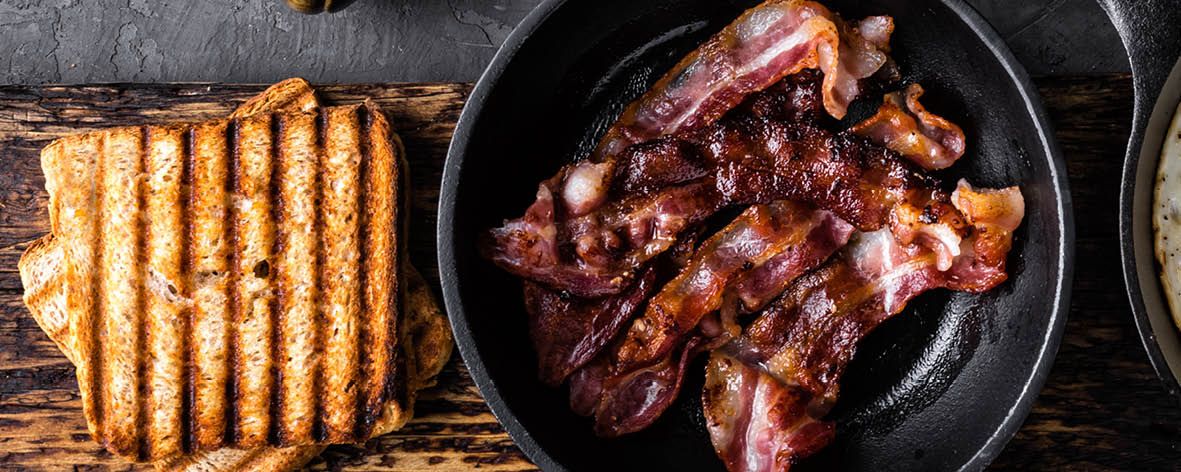Cooking bacon ... three ways to achieve perfection

Mmmm… bacon. There are some people who say everything tastes better with bacon … oh and butter, yes butter is good too. But bacon, just the mere sound of that word is enough to make many people drool. There’s something so satisfying about that sizzling sound and bacon aroma wafting through the kitchen.
Bacon is a versatile little ingredient too, popping up on the breakfast table, as well as in many lunch, dinner and even dessert recipes. It’s really important then, to make sure that your bacon cooking skills are solid. You don’t want to be that person who disappoints by serving up soggy, fatty rashers or at the other end of the scale, rashers so charred they are unrecognisable as food.
Relax because we’ve got you covered with three techniques that will elevate you to the status of bacon whisperer. Read on and learn what to do and importantly, what not to do.
The Traditionalist
Traditionalists like to cook their bacon in a frying pan. Whether you are doing it this way because that’s the way you’ve always done it, or because you love the sensory overload of sound, smell and sight as your bacon sizzles away in the pan, you need to remember these important things:
Cooking Instructions: Always, I said ALWAYS start with a cold frying pan. If you add bacon to an already hot pan, you run the risk of scorching it. But before you even get to the pan stage, take your bacon out of the fridge about five minutes before frying. This will bring the fat back to its natural state, making it more suitable for frying. Use a flat pan, preferably cast iron. Place enough bacon in the pan to fill it up, but not so much that it overlaps. If it overlaps there will be sections of the bacon that don’t cook. And if there is too much space in the pan, the bacon fat won’t render properly and be released into the pan and the bacon can burn. Bet you didn’t think bacon cooking had so many rules! Once you have cooked both sides, take the bacon out of the pan. Serve immediately, or place on a plate with paper towels to collect the excess grease.
The Perfectionist
Perfectionists like their bacon perfectly straight, perfectly crisp, every time. They don’t want to mess around with a little bit crispy, a little bit not. And they certainly don’t appreciate it when their bacon twists and curls in all different directions. No. Perfectionists want their bacon to look like it does on TV commercials, and to taste like it does in restaurants. Perfectionists bake their bacon in the oven. This is the method most commonly used in restaurants.
Cooking Instructions: Preheat the oven to 175 degrees. Arrange the bacon on a slotted tray (or something similar) with a catch tray beneath it for the bacon grease. Cook the bacon for about 10-15 minutes, but be sure to keep a close eye on it because it’s a fine line between crisp bacon perfection and charcoal!
The Convenient Cook
This cooking method is for those who are all about instant gratification. If you like your bacon and you want it fast, this is the method for you. Many people say that they cannot taste the difference between this fast method and the traditional fry pan method, but that is up for debate. One thing we can say for sure about this method is that it is quick, easy and requires little fuss.
Cooking Instructions: All you need to get this done is a microwave, a plate and a decent supply of paper towels, and by decent we mean a lot. Place a minimum of three pieces of paper towel on your plate then add a single layer of bacon (approx. 3-4 strips depending on your plate size). Now pay attention because this bit is important, before you hit “start” on that microwave make sure you cover your bacon on the top with a few pieces of paper towel. The paper towel will soak up the bacon grease that would normally be released into a pan, so don’t forget it or you’ll be scrubbing the walls of your microwave for the rest of the day. Cook for 4-6 minutes, depending on the power of your microwave.
So there you have it, our top three techniques for makin’ bacon; it’s time to choose your favourite and get cooking!

